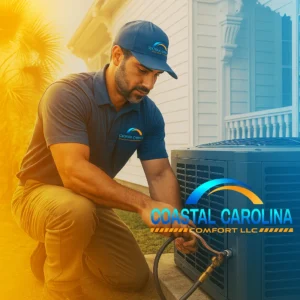You’re not losing your mind if your living room feels like the Sahara and your bedroom like the Arctic. That’s singalong number one your AC thermostat’s on the fritz. If poking at its screen gets you nowhere, congrats, that’s sign number two. Experiencing the joys of short cycling or your thermostat playing pretend with temperature readings? Yup, more red flags. Found yourself nudging the thermostat settings more than your pet nudges you for treats? There’s your sign. And if your AC’s running like there’s no tomorrow, it’s not enthusiastic—it’s confused. Stick with me, and we’ll explore how to show it who’s boss.
Inconsistent Room Temperatures
Ever walked into a room and thought you’d stumbled into the Sahara, only to find the next room could double as a meat locker? Well, you’re not alone, partner. This wild temperature swing hoedown might just point to a faulty AC thermostat.
Now, before you go blaming the poor thing, consider the unsung heroes of comfort: room insulation and ventilation efficiency. Poor insulation’s like wearing a T-shirt in a snowstorm—not gonna keep the warmth in. And if your ventilation’s as effective as a screen door on a submarine, you’re looking at the Wild West of indoor climates.
Unresponsive Thermostat Screen
While you’re checking if your home’s got a favorite chill spot, you might notice that your thermostat’s screen is as responsive as a teenager asked to do chores—yep, completely unresponsive. Before you start thinking it’s all doom and gloom, let’s talk turkey. First off, have a gander at the screen brightness. It might’ve decided to play hide and seek by dimming itself into oblivion. A simple adjustment can bring it back to the land of the living.
And if that doesn’t do the trick, consider a battery replacement. It’s like giving your thermostat a cup of coffee after it’s pulled an all-nighter. Just a little boost to get it back on its feet and ready to tackle the day—or in this case, your comfort needs.
Short Cycling Issues
Your AC’s got a mind of its own, short cycling like it’s trying to win a sprint instead of a marathon, leaving you hot under the collar and your home’s climate in a tizzy.
Now, you might think your AC’s just being finicky, but let me tell ya, this behavior’s a cry for help. Coolant leaks and wiring defects are often the culprits behind this erratic performance.
Imagine your AC’s like a car that can’t decide whether to stay in park or hit the road – it’s confusing and downright frustrating.
Incorrect Temperature Readings
Ever found yourself shivering or sweating and your thermostat swears it’s a comfy 72 degrees? You’re not going crazy; your thermostat might just be fibbing about the temperature.
Let’s tackle why your thermostat’s telling tall tales, how it’s messing with your cozy vibes, and how to set it straight without needing a detective.
Causes of Wrong Readings
Ain’t it a hoot when your trusty old thermostat starts telling fibs about the temperature? You’re either shivering in your boots or sweating like a sinner in church, and your thermostat insists everything’s just peachy. Well, buckle up, buttercup, because you might be dealing with some sneaky culprits behind those wrong readings.
First off, sensor problems are as common as flies at a picnic. If that sensor’s gone haywire, your thermostat’s as good as telling tales out of school. Then, there’re calibration issues, making your thermostat more confused than a goat on astroturf. It’s trying its best, bless its heart, but without a proper calibration, it’s just guessing.
Impact on Comfort Levels
How’s your living space feeling these days—more like an icebox or a sauna, thanks to that finicky thermostat lying about the temperature? You’re left shivering or sweating despite what that deceitful little gadget claims.
It’s not just about being too cold or too hot; this thermostat tomfoolery messes with both the humidity effects and air quality in your home. When it’s off, you’re battling either an unseen swamp of moisture or the Sahara in your living room.
Your quest for comfort turns into a wild goose chase, leaving you wondering if you’re just imagining things. But no, it’s not your imagination—it’s that pesky thermostat playing games with your sense of belonging in your own cozy nook.
Troubleshooting Misreading Thermostats
So, you’ve realized it’s not your imagination playing tricks on you—your thermostat’s got a mind of its own, huh? Well, welcome to the club of baffled homeowners!
First off, let’s talk battery replacement. It’s like feeding your thermostat a slice of power pie. If it’s still acting loopy, might be time to peek behind the curtain—or cover, rather. Wiring problems can make your thermostat throw a real tantrum, acting all sorts of unpredictable. It’s like it’s trying to communicate in Morse code, but all you’re getting is gibberish.
Thermostat Fails to Start AC
When your thermostat acts more stubborn than a mule at a county fair, refusing to kick-start your AC, you know you’ve got a problem.
Now, don’t go blaming yourself just yet. Sometimes, the solution’s as simple as a battery replacement. Yep, just pop in some new ones and it might spring back to life, eager as a puppy on its first walk.
If that don’t do the trick, it’s time for a wiring inspection. You’d be surprised how often wires decide to play hide and seek behind the scenes. They either get loose or cross paths like two squirrels chasing each other.
Sudden Increase in Energy Bills
If your wallet’s feeling lighter than a feather at a pillow fight, it might be because your AC’s thermostat is acting up, driving those energy bills sky-high.
See, when that little gadget decides to throw a tantrum, it forgets all about energy efficiency. It’s like it’s throwing your hard-earned cash out the window, just to keep itself entertained.
Now, you don’t need to be an expert in bill analysis to notice when your monthly dues start looking more like a phone number than a payment amount. That’s your cue to give that thermostat a good talking to, or perhaps, show it the door.
Frequent Setting Adjustments Needed
You’ll find yourself playing thermostat DJ, constantly adjusting the settings, as if your home’s climate control has decided to live its own unpredictable life. It’s like it’s throwing a tantrum, demanding more attention than a puppy.
Now, why’s it acting all moody? Well, power surges could be your party crashers here, messing with your thermostat’s brains. Or, it might just be crying out for a simple battery replacement, kinda like how we get cranky when we’re hungry.
AC Runs Constantly
Despite your best efforts to play it cool, your AC might decide it’s on a marathon, running non-stop like there’s no finish line in sight. You’re there, scratching your head, wondering if it’s training for the Olympics or something. But let me tell ya, this ain’t normal. It’s a telltale sign something’s up with your thermostat or maybe it’s just throwing a tantrum.
Before you start considering a pep talk, let’s get practical. A bit of AC maintenance could go a long way. Maybe it’s just screaming for a filter replacement, like a kid with a dirty diaper. Don’t ignore the cries for help. Show it some love, and you might just get your quiet, efficient buddy back, resting between sprints like it’s supposed to.
Thermostat Loses Programming
Ever felt like your AC’s got a mind of its own, flipping from Arctic chill to Sahara heat without so much as a by-your-leave?
You’re not losing your marbles; it’s your thermostat forgetting its manners, and programming, faster than a goldfish.
If you’re constantly hitting the reset button, it’s time we talk turkey about why that little gadget’s acting more finicky than a cat at bath time.
Erratic Temperature Control
If your AC’s been acting more unpredictable than a cat in a yarn shop, it might just be a case of the thermostat losing its marbles, or programming, to be more precise.
You’re sitting there, sweet as pie, thinking you’ve got the temperature set just right. Then, outta nowhere, you’re hit with temperature swings wilder than a rodeo bull. One minute you’re in the Sahara, the next, Antarctica. That’s your first clue of control failure.
It’s like your thermostat’s got a mind of its own, forgetting whether it’s supposed to cool you down or turn your living room into a sauna. Welcome to the rollercoaster of erratic temperature control, folks. Buckle up, it’s gonna be a bumpy ride.
Frequent Resets Needed
You know your AC’s thermostat’s gone haywire when it demands more resets than a moody teenager with a smartphone. It’s like it’s got a mind of its own, forgetting the temperature you painstakingly set, just to mess with you.
Now, why’s it acting all high and mighty? Well, it could be throwing tantrums due to power surges or wiring problems. Think of power surges as too much excitement for its circuits, and wiring problems like it’s got its wires crossed – literally.
Both can make your thermostat lose its marbles, or in this case, its programming. So, next time it acts up, remember, it ain’t just being difficult. It’s probably crying out for a little help with its internal drama.
Unusual AC Behavior
Your AC’s acting weirder than a cat in a bathtub, and it just might be the thermostat throwing a fit. Picture this: one minute, your home’s as chilly as a polar bear’s toenails, and the next, you’re sweatin’ like a sinner in church. If that ain’t a sign of a thermostat with more mood swings than a teenager, I don’t know what is.
And let’s not get started on those AC noises that sound like a ghost with a sore throat. Could be filter problems making your AC wheeze and sneeze more than your allergy-prone aunt at a cat show.
Y’all, it’s time to give that thermostat a stern talking to, or better yet, call in the pros before your AC decides to retire early.
Frequently Asked Questions
Can a Faulty AC Thermostat Affect Indoor Air Quality and How?
Yes, a wonky thermostat can mess with your indoor air by causing temperature swings and playing havoc with humidity control. You’ll be hotter than a hen in a wool sock or colder than a snowman’s toes!
What Are the Potential Safety Risks Associated With Ignoring a Malfunctioning AC Thermostat?
Ignoring a wonky AC thermostat isn’t just a quirky home feature; it’s a gamble with fire hazards and electrical risks. You’re practically inviting a barbecue you didn’t plan, and not the fun kind!
How Does the Age and Type of an AC Thermostat Impact Its Likelihood of Failure?
Older thermostats are like grumpy old-timers; they’re set in their ways and fail more often. Technology advancements mean newer models need less fussing. Remember, maintenance frequency keeps your AC buddy happy and your home cozy.
Are There Any DIY Methods for Recalibrating an AC Thermostat, or Should It Always Be Handled by a Professional?
You can try some DIY calibration techniques, but it’s like herding cats sometimes. For peace of mind, a professional consultation’s your best bet. They’ve got the magic touch that makes your AC behave right.
How Does Extreme Weather, Such as a Heatwave or Cold Snap, Influence the Performance of an AC Thermostat?
When it’s hotter than blue blazes or colder than a well digger’s ankles, your AC thermostat’s weather resilience is tested. Extreme temps can throw off calibration accuracy, making you feel like you’re living on Mercury!
Conclusion
Well, butter my biscuit, it seems your AC’s brain – the thermostat – might be a tad forgetful or just plain stubborn.
If it’s acting more finicky than a cat in a room full of rocking chairs, from ignoring your pleas for cooler air to taking unscheduled siestas, it’s time to give it a good talking to or maybe even show it the door.
Remember, a happy home keeps its cool, so don’t let a quirky thermostat turn your place into a hot mess.
More on Coastal Carolina Comfort’s AC Repair Services.


